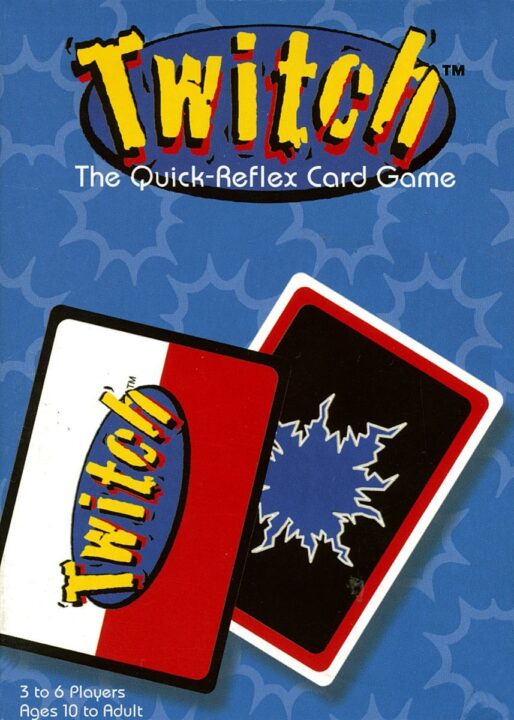Ever wondered what would happen if your game night got struck by lightning, and everyone started scrambling around the table like caffeinated squirrels? Well, that’s pretty much what happened the first time my group pulled out Twitch. Welcome to my review, where I’ll help you figure out if this game will make your next hangout legendary or just leave you wishing you’d picked something with fewer flying elbows. Grab a snack, maybe some safety goggles, and let’s get started!
How It Plays
Setting up
Dump all the cards in the middle of the table. Everyone grabs a buzzer, if you have them, or just get your hands ready. Pick someone to read the first card. That’s pretty much it—no ten-page rulebooks here!
Gameplay
Each round, the reader flips over a card and shouts out what’s on it. Most of the time, it’s something like, “Touch your nose and shout ‘Banana!’” The fastest player to do the silly thing first scores the card. Sometimes the instructions are so nuts, you forget you’re wearing pants. The game is full of yelling, hand slapping, and lots of arguing about who was actually first.
Winning the game
When all the cards are gone, everyone counts how many they grabbed. Whoever nabbed the most cards is the winner. No tie-breakers. If two players have the same number, just brag until the other gives up!
Want to know more? Read our extensive strategy guide for Twitch.
How Twitch Keeps You Guessing: Gameplay and Rule Clarity
I brought Twitch out for board game night last week. The box looked harmless enough. I mean, the word “Twitch” sounds friendly, right? Wrong! This little game had me sweating more than that time I tried to eat a whole chili pepper in one bite. The gameplay is all about fast reflexes and sharp attention – if you blink, you miss, and if you miss, you lose. Everyone gets a bunch of cards, and you flip them over one at a time, waiting for a matching symbol to show up. The moment it does, it’s a mad scramble as everyone tries to grab the Twitch stick in the middle. If you snag it first, you win. If your cousin Stan launches himself across the table and knocks over your drink in the process, well, that’s just extra chaos for you.
Rule clarity? I’ll be honest, the rules for Twitch are simple. Almost too simple. Sometimes, the booklet felt more like Ikea furniture instructions – short, but still left me scratching my head once or twice. There are a few special cards that tweak the grabbing rules, and those could’ve used better examples. Me and my friends squabbled over the ‘double grab’ rule more than who ate the last slice of pizza. After a round or two, though, everyone had the basics down. Just know, if your group includes serious rule-huggers, Twitch might have them rewriting house rules before dessert.
Next up, I’ll tell you how trying to snatch that stick turns even your quietest friend into a cackling maniac. Get ready for the wild side of Player interaction and engagement!
Twitch: The Social Rollercoaster of Board Games
Twitch is one of those board games that truly tests the friendships at your table, often in hilarious ways. When I first convinced my friends to play Twitch, I expected the usual polite chatter and maybe a little competitive banter. What followed was, frankly, a cacophony of giggles, mild panic, and a few accusatory glares across the table. This game has a knack for pulling everyone in and refusing to let go.
The best thing about player interaction in Twitch is that you can’t really zone out. My buddy Dave tried to check his phone once, only to be jolted by a sudden rule switch that left him floundering for dear life. Everyone has to keep their eyes peeled, and being quick-witted or nimble-fingered (or, in my case, a blend of both and a touch of luck) keeps the energy levels sky high. Each round, the rules swap or the objectives change, so the game demands constant attention. If you’re prone to monologuing or daydreaming, Twitch will snap you back to reality faster than you can say “wait, what just happened?”
Another thing I noticed is how Twitch encourages everyone at the table to get loud. There’s no hiding in the corner with this one. Shy, quiet players? Not for long. Twitch somehow turns even the most reserved folks into accidental comedians. It gets raucous in the best sense, and lets everyone share the spotlight (or the blame) for a round gone wrong.
Now, before we all get carried away with the fun, let’s see if skill really rules Twitch, or if Lady Luck is just playing tricks on us next…
Luck vs Skill: The Wild Tug-of-War in Twitch
Let’s talk about what really sticks in my board gaming craw: luck versus skill. Twitch is a game that will make you question if you’re a true game master or just blessed by the Board Game Gods. While there is some room for skill—quick thinking, sharp eyes, and maybe that ability to fake confidence when you have no idea what you’re doing—a good chunk of your fate lands squarely in the hands of Lady Luck.
In my first play of Twitch, I strutted in like I was the king of reflex games. Turns out, my brain took a vacation. I’d picture myself racking up points with lightning reflexes and clever tactics, but then a random card flip would send my plans tumbling like a poorly built Jenga tower. Sometimes you’re the speedy hero, other times you’re just caught staring while your friends snatch victory from your clammy hands. It’s frustrating if you’re allergic to randomness. If you love skill-based competitions, prepare for a little heartbreak. If you’re okay with a pinch of chaos and the thrill of unpredictability, Twitch brings everyone along for the ride, so even your least competitive friend can feel like a champion (or at least not a total failure).
All in all, Twitch sits firmly on the luckier side of the board game universe. If luck decides to ghost you, there’s not much you can do to claw your way back. But if you’re looking for a game night filled with laughter and groans in equal measure, you’ll survive. Next up, let’s see how many times you’ll actually want to play this thing—and how long you’ll be glued to the table!
Replayability and How Long Does Twitch Take?
If you’ve ever played Twitch at a party, you know why people keep coming back. This isn’t a dusty, once-a-year game. Twitch begs to get pulled out on game night because it’s fast and wild. Each game lasts about 10-20 minutes, so you can fit in a bunch of rounds before anyone has to pretend they’re not tired at 10pm.
The best bit about Twitch is it feels fresh every time. Since the tasks and actions are a bit bonkers—and change from round to round—you never quite know what is going to happen. Last weekend, my friend Ben somehow won three times in a row, while I ended up spilling juice on my own sock. No two games are alike, unless you get unlucky enough to have another juice sock moment (here’s hoping you don’t).
But, and it’s a big but, if your group is super into strategy-heavy games, Twitch may not hold up over many playthroughs. It’s way more about silly moments than deep thinking. Still, for most people, it’s a go-to for quick, hilarious games between heavier stuff. If anyone in your group is allergic to losing because of luck, this one’s probably not for them.
So, do I recommend Twitch? If you love laughs, fast games, and light rules, then YES, 100% add it to your shelf. Just maybe keep your juice away from your socks.
Conclusion
Twitch is a wild, party-friendly board game that kept my group buzzing, laughing, and occasionally yelling at each other (sorry Stacy, I didn’t know your reflexes were that slow). If you want a quick game that gets everyone involved, Twitch does the trick. The rules are mostly clear, though we had to double-check a few bits when things got too heated. Fair warning: if you like games about skill or clever moves, Twitch won’t scratch that itch—luck rules the table here, so don’t take it too seriously. Still, as a way to break the ice and get everyone moving, it’s solid fun and always worth a spot at my party table.
This wraps up my review; now go annoy your friends with those twitchy reflexes.


